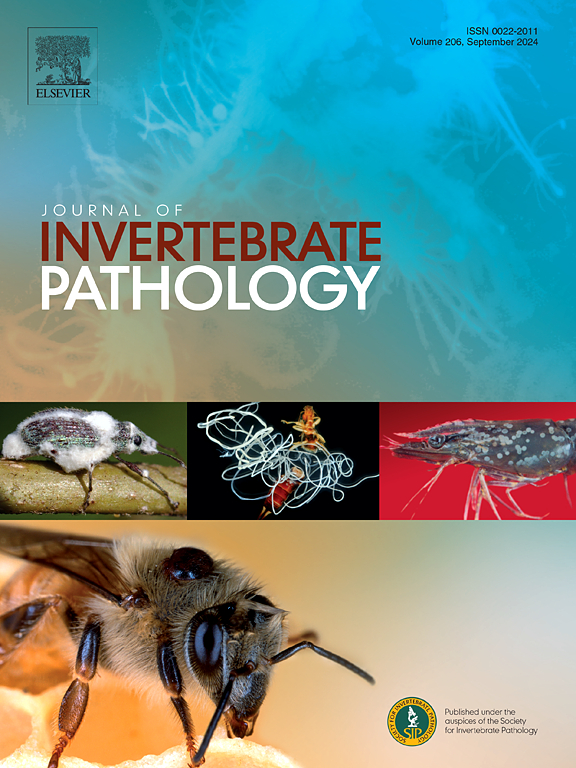Host-parasite interplay within a phoronid-microsporidia system: anti-parasitic defense in Lophophorata
IF 2.4
3区 生物学
Q1 ZOOLOGY
引用次数: 0
Abstract
Microsporidia (Opisthokonta: Rozellomycota: Microsporidia) are ubiquitous intracellular parasites infecting representatives of all major taxonomic groups of Animalia, from protozoans to mammals, and infecting marine, freshwater, and terrestrial hosts. A representative of the phylum Phoronida was recently added to the list of microsporidian hosts. Only one species Microsporidium phoronidi, a parasite of Phoronis embryolabi, has been recently described. The paper presents further study of this host-parasite system, specifically, the observation of an efficient anti-microsporidial defense reaction in a phoronid host, and a unique mechanism of clearing the host of infection. This defense reaction results in encapsulation of infected cells and subsequent releasing of the capsules through excretory ducts of metanephridia, together with larvae, which regularly leave the mother organism this way. We hypothesize that by encapsulation, phoronids destroy most of parasites, block spread of the infection throughout the body, and prevent horizontal transmission. At the same time, microsporidia that develop in vasoperitoneal tissue that nourish maturing oocytes and embryos, likely overcome the host defense by sporadic or regular infection of embryos. As a result, the parasite secures its persistence in host populations by vertical transmission, which, in turn, benefits evolving less pathogenic forms. Overall, such elaborated and well-balanced phoronid host–microsporidia parasite interactions may suggest long history of co-existence and deserve further studies. New data extend our knowledge about parasite-host interactions and immune response in Lophophorata.

寄主-寄主在寄主-微孢子虫系统内的相互作用:小孢子虫的抗寄生防御。
微孢子虫(Opisthokonta: Rozellomycota: Microsporidia)是一种普遍存在的细胞内寄生虫,感染从原生动物到哺乳动物的所有主要分类类群的代表,并感染海洋,淡水和陆地宿主。小孢子虫寄主名单中最近增加了一种孢子虫门的代表。最近只发现了一种佛罗尼微孢子虫,它是佛罗尼孢子虫的一种寄生虫。本文对这一宿主-寄生虫系统进行了进一步的研究,特别是在寄主体内观察到一种有效的抗微孢子防御反应,以及一种独特的清除宿主感染的机制。这种防御反应导致被感染的细胞被包封,随后胶囊连同幼虫通过后肾虫的排泄管被释放,幼虫定期以这种方式离开母体。我们假设,通过封装,寄生物杀灭大部分寄生虫,阻断感染在全身的传播,并防止水平传播。同时,在滋养成熟卵母细胞和胚胎的血管腹膜组织中发育的微孢子虫可能通过零星或定期感染胚胎来克服宿主的防御。因此,寄生虫通过垂直传播确保其在宿主种群中的持久性,这反过来又有利于进化出致病性较低的形式。总之,这种精心设计和平衡良好的寄主-微孢子虫寄生虫相互作用可能表明长期共存的历史,值得进一步研究。新的数据扩展了我们对寄生虫-宿主相互作用和免疫反应的认识。
本文章由计算机程序翻译,如有差异,请以英文原文为准。
求助全文
约1分钟内获得全文
求助全文
来源期刊
CiteScore
6.10
自引率
5.90%
发文量
94
审稿时长
1 months
期刊介绍:
The Journal of Invertebrate Pathology presents original research articles and notes on the induction and pathogenesis of diseases of invertebrates, including the suppression of diseases in beneficial species, and the use of diseases in controlling undesirable species. In addition, the journal publishes the results of physiological, morphological, genetic, immunological and ecological studies as related to the etiologic agents of diseases of invertebrates.
The Journal of Invertebrate Pathology is the adopted journal of the Society for Invertebrate Pathology, and is available to SIP members at a special reduced price.

 求助内容:
求助内容: 应助结果提醒方式:
应助结果提醒方式:


